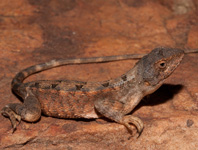Abstract
Moronius Grossi & Vaz-de-Mello, 2015 (Coleoptera: Scarabaeidae: Rutelinae: Rutelini) is the latest genus described within the subtribe Areodina (Grossi & Vaz-de-Mello 2015). Areodina consists of 11 genera distributed throughout the New World (10 genera) and Africa (one genus) (Jameson 1990; Grossi & Vaz-de-Mello 2015). Moronius is distinguished from other genera of Areodina by: 1) the pentagonal clypeal shape with the apex strongly reflexed, and 2) the hind wings with the anterior margin near RA1+2, RA1+3, and apical hinge setose. The South American genera of Areodina form a distinct clade (Jameson 1990) composed of Oplognathus MacLeay, 1819, Areoda MacLeay, 1819, and Byrsopolis Burmeister, 1844. Oplognathus and Areoda are differentiated by the presence of a forward-projecting mesoventral process, which is absent in both Byrsopolis and Moronius. These two latter genera are similar according to the characters presented in the Jameson (1990) phylogeny and are differentiated by habitus colour, shape of clypeus, and antennal club length (Grossi & Vaz-de-Mello 2015).
References
Grossi, P.C. & Vaz-de-Mello, F.Z. (2015) Moronius miguelangeli new genus and new species of Areodina from western Brazil (Melolonthidae: Rutelinae: Rutelini). Dugesiana, 22, 221–226.
Jameson, M.L. (1990) Revision, phylogeny and biogeography of the genera Parabyrsopolis Ohaus and Viridimicus, new genus (Coleoptera: Scarabaeidae: Rutelinae). The Coleopterists Bulletin, 44, 377–422.
Soula, M. (2010) Révision des Pelidnotina 4. Une Révision des genres Catoclastus, Homonyx. Retour sur quelques espèces ou groupe d'espèces de Pelidnota. Addenda 2010 (Coleoptera: Scarabaeidae: Rutelinae: Rutelini: Pelidnotina). Les Coléoptères du Nouveau Monde, 4, 1–65.

